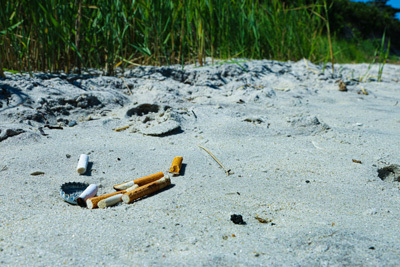
As the years pass, the shocking truths about smoking cigarettes continue to highlight why it is not just bad for general health and those around you but also for the environment.
With eight million lives a year lost globally from tobacco, that alone is enough evidence to suggest the danger that smoking poses.
It’s the most littered item globally, with trillions of cigarette butts found in oceans, beaches and pathways each year. With that in mind, how bad is it for our planet and why? What can be done to reverse the damage and provide a better future?
To understand this, we must look at the journey of making a cigarette to the trillions that are puffed each year and then disposed of.
The Lifecycle of a Cigarette
With so many cigarettes in circulation each year, purchased and smoked daily and habitually as an addiction, a lot of space is needed to grow tobacco plants.
To do this, 4.3 million hectares of land are used to produce cigarettes, culminating in the needless destruction of forests, harming biodiversity and degrading soil in the process.
Estimates suggest 11.4 million metric tonnes of wood are cured to make tobacco. And in addition, 22 billion tonnes of water in tobacco production.
Once the tobacco leaves are harvested, they undergo various processes to create the final product. From drying and curing to blending and flavouring, each step in the production process requires time, effort and local resources. The constant use of pesticides, herbicides, and fertilisers contaminates the environment and wildlife.
What About Its Impact on Wildlife?
These chemicals can end up in water bodies, affecting aquatic life and potentially entering our food chain. The majority of tobacco is produced in low and middle-income countries, challenging the environment and economy of its people.
Then the world has to consider the chemical elements used in production and how they negatively impact the environment. They seep into water and soil, which is bad for not only human health but animals too.
How cigarette butts impact wildlife is often overlooked as well. Animals, including birds, fish, and mammals, can mistake discarded cigarette butts for food or the right sort of materials to create a nest.
Ingestion of these toxic waste products can lead to severe health issues and even death. Additionally, animals can become entangled in cigarette packaging and suffer injuries or suffocation. Something needs to be done about this fast to protect our wildlife and ecosystem.
How Does Smoking Pollute the Air?
Not only does smoke damage your heart, arteries, lungs and several other areas of the body, but it also does significant harm to the air we breathe. Toxic emissions produced by tobacco on an annual basis are equal to roughly three million transatlantic flights!
It impacts greenhouse gases and releases dangerous air pollutants like carbon monoxide and about 2.6 billion kilograms of carbon dioxide per year, as well as 5.2 billion kilograms of methane into the atmosphere.
Even the transportation of tobacco leaves in the production process, while necessary for the industry, creates so much air pollution. Tobacco smoke produces higher particulate matter pollution than diesel exhaust, which highlights the risks faced when tobacco farms are created. And with second-hand smoke, smokers are also releasing thousands of dangerous toxins into the air, harming those in the vicinity.
Toxins trickle into the earth slowly from cigarette butts, taking 14 years to do so, which are not biodegradable, plus the plastic filters damage the land too. Cigarette filters are made of cellulose acetate, a type of plastic that can take years to decompose. As they break down, they release microplastics into the environment, further polluting our ecosystems. The impact and shift it has helped to create towards global warming is both clear and alarming.
The packaging of cigarettes also contributes to waste and litter. The glossy cardboard boxes, plastic wrapping, and foil-lined inner packaging are often discarded improperly, adding to the growing problem of plastic waste. Improper disposal of cigarette packaging not only tarnishes our environment but also adds to the challenges of waste management, requiring additional resources to clean up and process.
What Can Be Done to Combat This Threat to Our Environment?
The tobacco industry, perhaps feeling threatened by the decline in popularity and the rise of the vaping industry, is recognising the need for change. And so is the Uk government, with their goal to reduce smoking prevalence to below 5% by 2030. One of the key areas of focus is sustainable tobacco farming. By implementing organic farming methods and reducing the use of harmful chemicals, companies aim to minimise the impact on soil, water, and ecosystems. This is a step in the right direction.
But more needs to be done by governments and regulatory bodies, who have a key part to play in addressing the environmental consequences of cigarettes. Stricter rules must be implemented across the board in all of the areas we have described above from deforestation and littering to tobacco farming and consumer behaviour and awareness.
By supporting these alternative solutions and initiatives, consumers can make a difference. However, it is crucial for not just consumers but governments and organisations to support and not just talk the talk but walk the walk with action. Let us stub out the truth and pave the way for a healthier, more sustainable future.




1 thought on “Is Smoking Bad for the Environment? ”
Comments are closed.